|
 Notes Concerning JOHN SMITH Notes Concerning JOHN SMITH
(10 May 1807 - 22 Feb 1896)
Made by his great-grandson, the late Donald S Smith
- 2nd Edition July 2001.
Until the autumn of 2000 I knew very little about my great-grandfather, John Smith. He was an amateur astronomer who published a Weather Guide and Almanac for some 16 years up to his death. I also knew that he made sundials, and that there was an example of his work in a park in Middlesbrough. My cousin, John Morley Smith, has a bronze sundial made by JS in the 1870s. It has been in his family all John's life, as has a copy of the 1899 edition of the almanac which was published by Heavisides in Middlesbrough, ie two or three years after JS's death but still bearing his name. The almanac includes an advertisement for sundials made of various materials. See below.
A family tree drawn up 20 years ago by my cousin William Dan Burningham, and updated by cousin John showed JS as having three children, William Gorbutt (my grandfather who died in 1894), Gorbutt and Rachel, Cousin John also has a letter written by JS on 6th May 1895 to our (by then widowed) grandmother Georgina in Crewkerne asking if two of his granddaughters could attend his 88th birthday celebration. The letter mentions that Gorbutt and Rachel would be coming from York and Manchester respectively.
That was about all I knew a year ago. I was determined to find out more about JS, and my wife Pat and I began by spending a week on Teeside in October 2000. Our first find was the sundial in Albert Park, Middlesbrough. It is south facing, vertically mounted on a specially built plinth and carved in a rather soft stone which is badly eroded (but see update later).
I had established contact beforehand with the Middlesbrough archivist (Janet Baker) and we visited the archives on Mon 8 Oct. The visit was far more fruitful than we had dared to hope. We began by looking at the 1891 census. The letter written by JS gave his address, 9 Mansfield Street in Thornaby and sure enough there he was (shown as a widower and also as a meteorologist!), together with a 24 year old servant (one Sarah Rutter) and, more importantly, another son. Henry B Smith was then aged 36, unmarried, and described as a signalman. Cousin John had lent us the 1899 almanac and we noted that the advertisement in it for sundials directed those interested to Mr HBN Smith at 9 Mansfield Street. So Henry had stayed on in the house after the death of his father. This first look at a census was the start of considerable research into JS's immediate family. The results are recorded later in these notes.
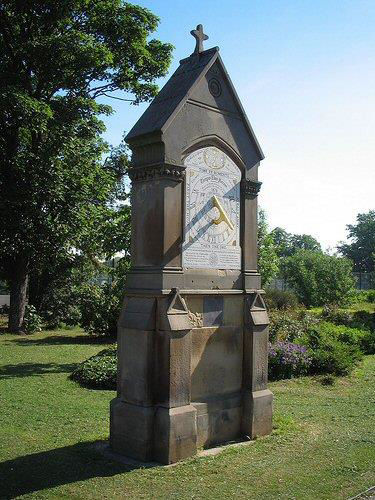
Albert Park Middlesborough - a sundial by John Smith |
While we were working our way through the census microfilm, one of the archive staff (Ann) located a large envelope containing several items relating to John Smith and the Middlesbrough sundial. Included was a memoir about JS written at the time of the erection of the sundial. This reveals that he was bom in Bielby, Yorks, the son of a farmer, and developed an early interest in astronomy and sundials. He made one for his father, and another for the Wesleyan chapel opened in his native village in 1837, where he was a lay preacher. Father needed his son's labour on the farm and was not impressed by John's preoccupation with his interests. Thus all the hobby work took place at night, much of it by candlelight.
I managed to establish contact with a Methodist minister in Pocklington, which is close to Bielby. The Bielby chapel is still there but ceased to be used as such in the 1980s and is now a dwelling. He believed that the sundial was still there. In June 2001 Pat and I spent a few days in Yorkshire and visited Bielby. The chapel is now called Wesley House, and is a grade 2 listed building. It is very attractive and was converted by the father of the present lady occupant. The south-facing sundial is made of painted stone, located centrally on the wall above the front door. It bears JS's name and is in excellent condition.
The memoir also records that in 1830 JS made a 'piece of mechanism' for measuring road distances which he attached to a rear wheel of his father's wagon. It had two pointers: one rotated every mile and the other every 36 miles, and each time the former rotated it rang a bell! The making of the mechanism was recorded in The London Mechanic's Magazine edited by the then Lord Brougham, and the memoir includes an extract which ends "The above workmanship reflects great credit on the young man, as he has executed the work at nights, after his daily labour was done". Another source records that the whole village turned out to cheer the wagon on it maiden voyage to measure the four miles to Pocklington.
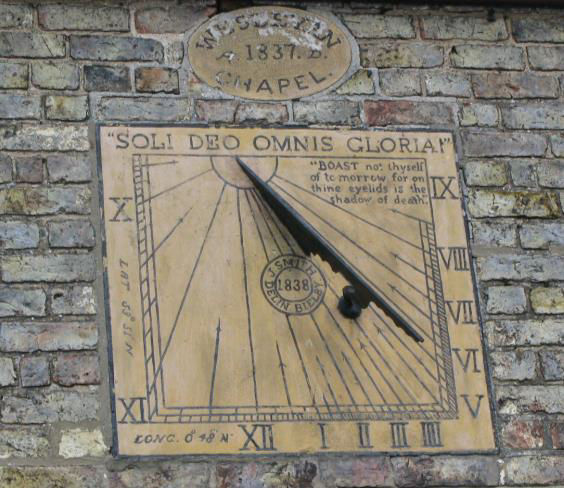 |
Bielby Chapel Sundial made by John Smith in 1838 |
According to the memoir JS, moved from Bielby in 1842 to a farm at Spaldington Outsides. The family tree previously mentioned gives no information about JS's wife and the memoir contains nothing about family. JS moved twice more: the memoir records that he relocated 12 miles north of York to Craike (now spelt Crayke) 18 years after arriving in Spaldington, ie probably in 1860. In 1875 he moved to 'South Stockton'. (In the 1891 census Thornaby was recorded as a 'Civil Parish' in South Stockton). These changes in location were confirmed in family details found in census returns and are reflected later in these notes.
The Middlesbrough archive includes burial records. JS was buried in the 'Old Cemetery' on 26 Feb 1896 and his Burial Register reference is 331/6552. The grave reference was given as row Y, no 91. Unfortunately there was no plan of the cemetery but we paid it a visit and carried out quite a thorough search. There were plenty of contemporary headstones but we were unable to find one for JS. There was a good deal of open space in the relevant area and one must presume, therefore, that there are many unmarked graves.
 |
People's Park Halifax - a John Smith Sundial |
The documents we saw in the Teeside archives included a hand-written memo from a Rev Richard Robson sent from Castle Howard in 1995. This said that the prototype of the Middlesbrough sundial (made of wood) used to be on a wall of the stable block at Castle Howard. I called the administrator at Castle Howard - was the sundial still there? He thought not, but gave me a telephone number for Richard Robson. He is now Bishop Stephen of the English Orthodox Church and based in York. I spoke to him and he related the following.
The sundial was offered to Castle Howard circa 1970. (Later info puts it in the 60s). It had apparently been in the possession of a descendant (grandson?) of JS who had recently died in the York area. For reasons unknown the person clearing up the estate offered it to Castle Howard. The letter about his birthday written by JS in 1895 mentions that his son Gorbutt would be coming from York. It seems likely that the gift to Castle Howard came from that branch of the family. The stable block at CH was then a costume museum and the sundial was mounted on a south-facing wall. Unfortunately, the lady then running the museum did not document the circumstances of the donation.
Around 1994 it was decided to close the museum. The sundial had been refurbished and was in good condition. Richard Robson, as he was then known, was working there and felt that it should not be left to deteriorate. Because of its clear link with Middlesbrough he offered it to the Dorman Museum, which is alongside Albert Park. They snapped it up!
I spoke to Ian Stubbs, the assistant curator at the Dorman. The wooden item is in pristine condition having been worked on at CH, and further restored at Middlesbrough. He told me that a heritage fund lottery grant has been awarded for a three-year programme to improve Albert Park. The original in the park is in such poor condition that replacement rather than refurbishment will form part of that programme. The wooden prototype will remain in the museum and will be used as a model for the replacement stone item.
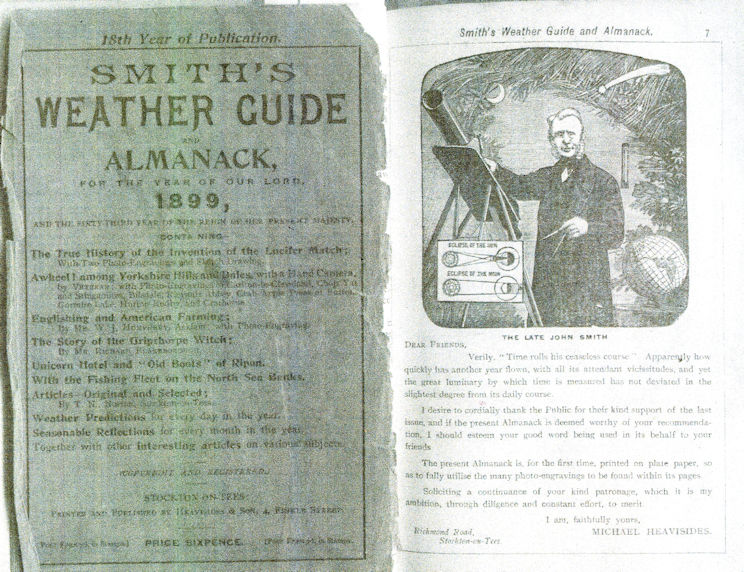 The memoir contains another significant reference to JS's skill as a sundial maker. A few years after he moved to Spaldington his landlord, Sir Henry Vavasour, decided to build a school. JS offered to make a sundial to stand in front of the school and the offer was accepted, but although made it was never erected due to the estate changing hands. Some years later it was bought by a Halifax alderman and presented to the committee of the Peoples Park of that town, where it was erected and stands to this day. I contacted the Halifax archives and was passed on to Deborah Comyn-Platt of Calderdale Council Community Services Directorate. She is administering a heritage lottery grant awarded to refurbish the park, including the sundial. At the time of producing this second edition the sundial work is part completed and should be finished soon. The memoir contains another significant reference to JS's skill as a sundial maker. A few years after he moved to Spaldington his landlord, Sir Henry Vavasour, decided to build a school. JS offered to make a sundial to stand in front of the school and the offer was accepted, but although made it was never erected due to the estate changing hands. Some years later it was bought by a Halifax alderman and presented to the committee of the Peoples Park of that town, where it was erected and stands to this day. I contacted the Halifax archives and was passed on to Deborah Comyn-Platt of Calderdale Council Community Services Directorate. She is administering a heritage lottery grant awarded to refurbish the park, including the sundial. At the time of producing this second edition the sundial work is part completed and should be finished soon.
 Following the visit to Teeside we explored the family research facilities provided by The Church of Latter Day Saints, better known as 'The Mormons'. There is a Family History Centre in Nottingham, one of 3000 worldwide, and Pat and I have made considerable use of it during the first half of 2001. By using material permanently held there, and by ordering microfilms from a central depot for a one-month loan, we have been able to examine relevant census and parish records for JS's immediate family with very interesting results. I will detail the story mainly in chronological order. If only the research had been that simple! Following the visit to Teeside we explored the family research facilities provided by The Church of Latter Day Saints, better known as 'The Mormons'. There is a Family History Centre in Nottingham, one of 3000 worldwide, and Pat and I have made considerable use of it during the first half of 2001. By using material permanently held there, and by ordering microfilms from a central depot for a one-month loan, we have been able to examine relevant census and parish records for JS's immediate family with very interesting results. I will detail the story mainly in chronological order. If only the research had been that simple!
In a bulletin about the Middlesbrough sundial written by Dr John Wall and issued by the British Sundial Society (94.3 dated Oct 94) JS's father is named as William. In the 1841 census for Bielby I found a farmer William Smith (age 68) with a wife Rachel (60) and children William (25) and Phebe (30) (spelt without an 'o'). The fact that JS called two of his children William and Rachel convinced me that I had correctly located his parents, and this was confirmed when I discovered that a William Smith married Rachel Gorbutt at Sancton (8 miles west of Beverley, Yorks) on 19th April 1806. As shown later, JS gave several of his children 'Gorbutt' as a middle name.
In the 1841 census John Smith was still in Bielby, but had left the parental home and established himself as a farmer in his own right. He married Sarah Fentiman on 1st January 1833. Sarah was born in 1811 and baptised on 17 Nov in that year. An article on JS in a 1964 Methodist magazine included this anecdote:
"He was married on a Sunday, and it is worth recording that he did not let this important event interfere with his preaching, for he took three services that day, preaching on each occasion from the text 'And they all with one accord began to make excuses', quaintly observing when he came to the remark of the third person in the bible story who offered the excuse that he could not come because he had married a wife, that this was the worst excuse of the lot. He should have done as I have done, and brought her with him!"
John and Sarah had the following children while living in Bielby. Dates are those of their baptisms which would undoubtedly have been very soon after their birth.
Sarah - 23 Jun 33, (ie 6 months after the wedding - did this get a mention in the sermon?!).
Rachel-10 Nov 35,
Mary - 2 Sep 37 (buried 4 Oct 37),
William Gorbutt - 10 Aug 38 (Buried 2 Oct 38),
Elizabeth - 30 Jan 40, and
John Gorbutt - 9 Apr 41. (This is the son referred to as 'Gorbutt' in JS's 'birthday' letter).
In 1842 the family moved 8 miles to Spaldington Outsides where JS farmed 226 acres. The following children were born to John and Sarah in Spaldington.
William Gorbutt - 1842 (my grandfather) Samuel - 1847, Mary - 1849.
As I have not found baptism records for Spaldington these birth years have been determined from the ages given in the 1851 census.
Sarah died in 1849. In June 2001 we visited the area and discovered her grave in Hayton church cemetery (the parish church for Bielby). With great difficulty, the wording on the headstone was deciphered.
CREATED
IN MEMORY OF SARAH, WIFE OF JOHN SMITH
OF SPALDINGTON WHO DEPARTED THIS LIFE
ON THE 1 5th DAY OF FEBRUARY 1849 AGED 37
For if we believe that Jesus died and rose again,
even so them also which sleep in Jesus
will God bring with him. Thess. 1 Ch4, VI4
ALSO IN MEMORY OF TWO CHILDREN OF THE ABOVE WHO DIED........
Many other headstones in the cemetery begin with the word Sacred (to the memory etc). The use of the word 'Created' and the known ability of JS as a sculptor of stone sundials lead me to believe that he carved Sarah's headstone himself.
Thus John was left with six children. The oldest, Sarah, was only 15 and might have become the family housekeeper but the 1851 census shows that there were several servants in the household. A widow called Elizabeth Pettinger was already living in Spaldington. She was born Elizabeth Bilborough at Holme in 1811 and married John Pettinger on 3r June 1834. They lived in Spaldington, had a daughter, Ann Elizabeth, born in 1839, and a son John, born in 1841. The two Johns were buried within two weeks of each other in August 1842.
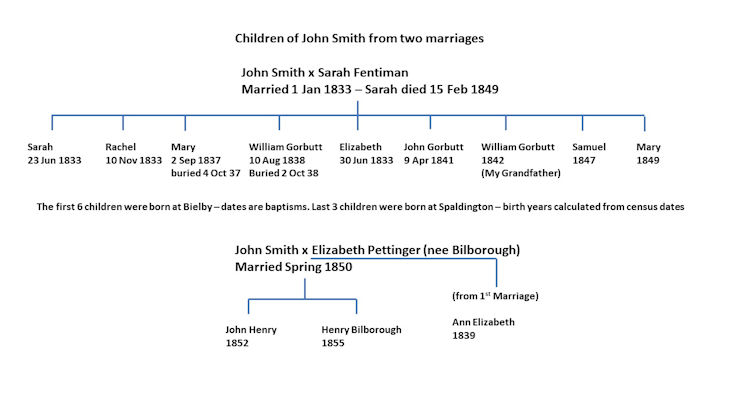 John Smith married Elizabeth Pettinger in the spring of 1850. Her daughter Ann lived with them, retaining the surname Pettinger, and the last reference to her was found in the 1881 census, unmarried, aged 43, and still with her mother and stepfather in Thornaby. John and Elizabeth Smith had two sons, both born in Spaldington. John Henry was born in 1852 and Henry Bilborough in 1855. The latter was also still living with his parents in Thornaby in 1881. As mentioned earlier, he was still there with his father (by then a widower) in 1891, and continued to live in the house after his father's death. John Smith married Elizabeth Pettinger in the spring of 1850. Her daughter Ann lived with them, retaining the surname Pettinger, and the last reference to her was found in the 1881 census, unmarried, aged 43, and still with her mother and stepfather in Thornaby. John and Elizabeth Smith had two sons, both born in Spaldington. John Henry was born in 1852 and Henry Bilborough in 1855. The latter was also still living with his parents in Thornaby in 1881. As mentioned earlier, he was still there with his father (by then a widower) in 1891, and continued to live in the house after his father's death.
We have found JS's household details in all the census returns for 1841 to 1891 (10 year intervals). Until he retired to Thornaby he was described as a farmer and Methodist lay preacher. In 1881 in Thornaby he had become 'Milk dealer and Methodist Preacher (seller)', and in 1891 'Meteorologist'! Apparently he produced weather forecasts based on the stars and these were displayed in the window of the Middlesbrough printing firm Heavisides (who produced the almanacs). Another recently acquired source states that during his Methodist lay preaching career he walked 20,000 miles to deliver his sermons. How this was discovered is not revealed, but I feel he was the kind of man who would have kept a record!
These family details have been discovered as a series of random findings but we were determined to produce as complete a family story as possible and I am confident that we have discovered all John's children. Finding it all has been frustrating at times but rewarding and exciting most of the time. I found it very moving to discover the grave of his first wife Sarah and stand and dwell on the life they led, in particular the loss of two very young children and Sarah's early death.
In carrying out this research I have become very fond of my great-grandfather. He was a truly remarkable man.
Donald S Smith, Aslockton, Nottingham.
July 2001.
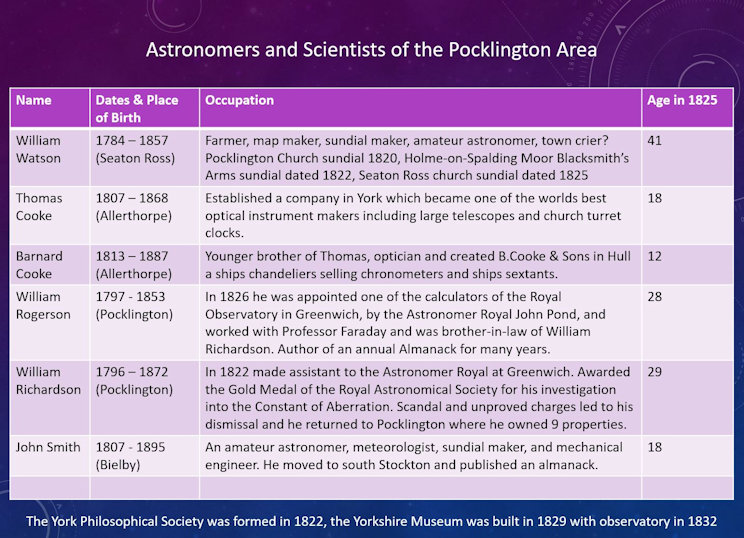
Possible source of astronomy and sundial education in Pocklington:

Nothing is known about J.R. Rowntree's school in Pocklington apart from the above advert. If you know anything about this school or indeed who J.R. Rowntree was, please contact us.
|

